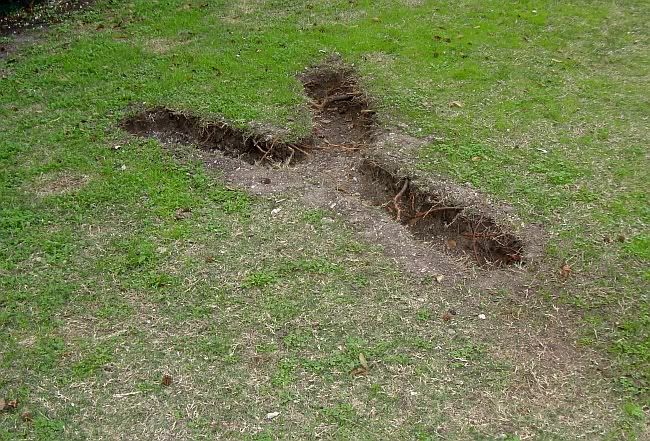T.J. Hunt, Breaking Ground, piles of dirt taken from various privately owned sites, 2012
T.J. Hunt's unfortunate artist's statement for her installation, Breaking Ground, reads, in its entirety:
My work is concerned with artistic identity and utility, investigating what it means to self-identify as an artist in the current age of ever-expanding artistic pluralism. By placing my work in dialogue with canonical artworks of the not-so-distant past, I attempt to examine my own position in an art historical lineage, often through absurd or overly literal gestures. For Breaking Ground, the physical landscape serves alternately as subject and as backdrop for these gestures, which become a vehicle for exploring ideas of ownership and appropriation.I thought she was going to miss out using the word "explore" but she came through at the end. Whew! It's not exactly "I do not seek--I find!," is it? Let me paraphrase it. "I do art about art in order to call myself an artist. This art you are reading about now is all that, and in addition to that it expresses ideas about private property and stealing."
Private property is indeed something worth thinking about. In fact, it has been on mankind's mind as a serious subject for thought since at least the 17th century when John Locke wrote his theories of property. Since then, private property has been the subject of major works by Adam Smith, Pierre Proudhon, Karl Marx, Oliver Wendell Holmes, Hernando De Soto, and many others. These thinkers are all quite profound. Given a universe of means to express their thoughts on the subject of private property, they all chose the same medium--prose.
The thing is, visual art is not a good way to think about (i.e., "explore") philosophical or political issues. This may not be an especially popular thing for an art critic to express. And in saying this, I'm not suggesting that artists shouldn't try. But subtle ideas don't lend themselves to images. (Other kinds of subtlety can be expressed by art quite well--feelings, moods, inherently visual ideas, etc.) That's why so much art that tries to deal with complex philosophical or political ideas ends up being extremely text heavy--with wall-texts or websites or artists statements, etc., carrying the conceptual load. But as far as I've concerned, when an artist depends on supplementary text like that, he's given up the game. He's conceded that text says what he wants to say better than image.
Indeed, to express her extremely vague, ambiguous and simplistic ideas about private property, T.J. Hunt has resorted to words (this is, I assume, the literalness she speaks of). But, one has to ask, is she in favor or private property? Opposed to it? Did she steal this dirt? Or did she ask permission? These are basic questions, but her supplies no answer, and more important doesn't delve into the questions themselves and their implications.
Now maybe I am putting too much of a burden on Hunt--asking her work to stand in for all political/philosophical installations. I think some artists are much much cleverer that T.J. Hunt, particularly those that implicate the viewer in their work. Hans Haacke, for example. But I see way too much work like Hunt's. For example, Andrei Molodkin's Crude at the Station Museum. What was pleasurable about Crude was seeing this contraption of pumps and transparent pipes and vessels pumping oil around in a circle. But like Breaking Ground, Crude had one simplistic idea to express, and even then it depended on wall texts to express it. (Perhaps it works as propaganda, which depends of a lack of subtlety to be successful.)
I discussed this work with a friend, and she scolded me. She said that better works of this nature could do the job better--that I couldn't condemn an entire artistic practice based on this one work, but that what I was seeing was a bad representative of that kind of artwork. If so, I look forward to seeing the piece of visual art of this sort that doesn't require a significant prose component in order to express a nuanced argument. Until then, I will continue to depend on writers to explain complex philosophical and political issues to me, and allow visual art to fulfill other important functions in my life.

T.J. Hunt, Breaking Ground "Y" from the lawn of Lawndale. 2112
Breaking Ground will be visible at Lawndale Art Center through February 25.

No comments:
Post a Comment